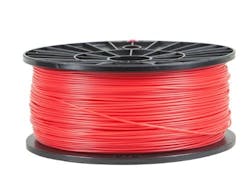3D printing filaments better and cheaper and greener every day
As we know, 3D printers make objects ... but eliminate the waste and high tooling costs of traditional manufacturing. Because the machines print parts off of CAD files, even weird or impossible-to-find parts are more affordable.
• Expensive, and
• Limited in its ability to offer good material properties once fused into a part.
1 — Cheaper filaments
In response, the e-commerce sale house Monoprice Inc., Rancho Cucamonga, Calif., offers super-cheap filament for other companies’ printers as well as its new $1,199 dual-color extrusion 3D printer — with the likably straightforward Product ID #11614. (The machine uses the company’s standard 1-kg, 1.75-mm filament spool and can print with ABS, PLA or PVA plastic.) ABS and PLA filament colors through monoprice.com include fluorescent yellow, crystal clear, bright orange, bright green, blue, red, purple, white and black.
Some users suggest that the filament has slightly lower consistency in color, melting temperature, and diameter than full “brandname” filament from Octave or Afinia. But the price — 1-kg spools for $34 — is hard to beat.
What's more, power-transmission component maker, igus inc., East Providence, R.I., a company that specializes in plastic parts, is entering the industry to improve filament offerings on another front — high-end OEM-type applications. The company is now selling a tribo-filament that makes parts with enhanced tribological (low-friction) properties. It’s 50 times more resistant to wear and abrasion than conventional 3D printer materials, and is ideally suited for creating custom bearings.
The company has tested the material extensively, and says it’s suitable for motion-control applications. igus carries 45 plastics for iglide products, with 100 custom materials for specialty designs. The new filament will let designers make their own bearing designs and prototypes. igus also offers access to 3D models of igus products in STL format, so designers can use those to drive the prints of their custom bearings.
3 — Filaments that are environmentally friendly
Taking another tack, researchers at Michigan Technological University recently published findings that it's actually cost effective and energy efficient to recycle the high-density polyethylene from milk jugs into filament for 3D printing parts.
"Indiana soybean farmers have supported this competition … to elevate our organization, Purdue, and Indiana as the center of food and agricultural innovation," says Jane Ade Stevens, CEO of the Indiana Soybean Alliance, sponsor of the competition.
The team — Carmen Valverde-Paniagua (future mechanical engineer), Nicole Raley Devlin (future chemical engineering Ph.D.), and Yanssen Tandy (future chemical engineer) — developed their filament Filasoy to replace petroleum-based plastic with a low-energy, low-temperature filament.
About the Author
Elisabeth Eitel Blog
Elisabeth is Senior Editor of Machine Design magazine. She has a B.S. in Mechanical Engineering from Fenn College at Cleveland State University. Over the last decade, Elisabeth has worked as a technical writer — most recently as Chief Editor of Motion System Design magazine.



